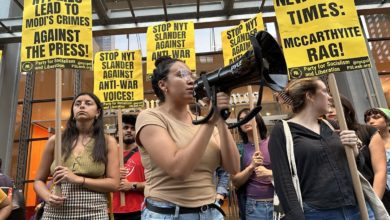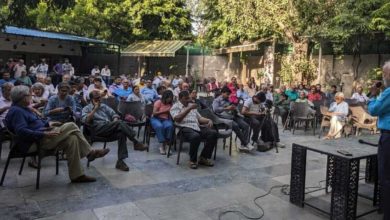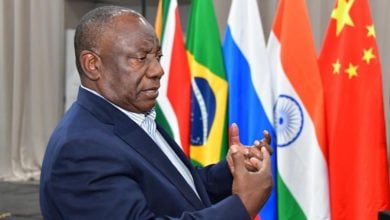This article first appeared in the January 2007 issue of Socialism and Liberation magazine.
On Nov. 26, the Tamil people of Sri Lanka celebrated Heroes Day. It is the day when the first fighter of the Liberation Tigers of Tamil Eelam (LTTE) lost his life in combat in 1982—a day dedicated to the memory of all Tamils who have died fighting for the right to self-determination.
During his annual Heroes Day speech, Velupillai Prabhakaran, LTTE founder and leader, declared the Norway-
 Tamil Tigers assist in tsunami relief, 2004. Photo: Jason South/The Age |
The LTTE, commonly known as the Tamil Tigers, has been fighting for an independent state for the Tamils since 1972. Eelam is the Tamil name for Sri Lanka; Tamil Eelam refers to the historic homeland of the Tamils in the northeastern region of the country.
Imperialists around the world, including the United States, Britain and the European Union, have labeled the LTTE a “terrorist organization.” The Sri Lankan government uses the label to justify its own state-sponsored terror against the Tamil people.
The fact is that the oppression of the Tamils long predates the birth of the LTTE and other armed national liberation organizations. A brief history of the country is necessary to understand the roots of the conflict.
The impact of European colonialism
Sri Lanka is a pear-shaped island off the coast of India slightly larger than the state of West Virginia. Its location makes it a strategic naval link between West Asia and Southeast Asia.
The Sinhalese and the Tamil peoples respectively account for about 74 percent and 18 percent of the population of Sri Lanka. Although there is dispute over who were the first to arrive, both Sinhalas and Tamils have inhabited the island for over two millennia. The Tamils are largely concentrated in the northeastern region of the country, especially in the Jaffna Peninsula.
European presence on the island dates back to the arrival of the Portuguese in 1505. Upon arriving, the Portuguese invaders encountered distinct kingdoms on the island. In particular, they encountered Tamil populations in the northeastern region and Sinhalese populations in the south among other smaller groups. They had distinct cultures, languages and religions as well as different socio-economic and political structures.
Over time, the Portuguese established their colonial rule by means of battles and treaties, yet they did not bring the different peoples under a single administrative structure. Likewise, the Dutch colonizers, who followed the Portuguese in the 17th century, set up separate administrative structures that reflected the distinct identities of the Sinhalese and Tamil peoples.
The British occupied the island in a series of bloody invasions beginning in 1795. By 1833, the British had imposed a unified system on the Sinhala and Tamil peoples. The island colony became known as Ceylon, and the forceful amalgamation of the Sinhalas and Tamils under the British colonial system laid the basis for the current conflict.
Masters of the divide-and-conquer game, the British played the Tamils against the Sinhalese in order to protect their colonial interests. The transformation of the once self-sufficient economy into an export-driven plantation economy necessitated a new class of English-educated professionals. The British encouraged the Tamils from the arid and less developed regions of the north and east to turn to English education and the professions for economic advancement. By granting the Tamils a stake in the colonial system, the British could use them as leverage against the Sinhalese majority.
After failing to integrate the Sinhalese into the plantation system, the British brought in Indian Tamils to work as indentured laborers in the fields. These Indian-origin Tamils had a distinct identity from the Ceylonese Tamil and also contributed to the make-up of the country.
The end of British rule
When British rule formally ended in 1948, the balance of power shifted dramatically. The exit of the British and the legacy of a unitary political system—as opposed to a federal arrangement or the formation of independent states—left the Tamils politically vulnerable. The Sinhalese majority quickly used its parliamentary majority to assert its dominance.
The Citizenship Act of 1948 and the Indian and Pakistani Residents Act of 1949 tied citizenship to descent. One had to prove three generations of paternal descent on the island in order to be granted citizenship. There were no provisions for citizenship by birth.
Although the new legislation applied to all on paper, in practice the targets were the Tamils of Indian origin. In the absence of an effective birth registration system in Ceylon, even those Indian Tamils who had been in Ceylon for generations were denied citizenship. Altogether, 90 percent of the total applications from persons of Indian origin were rejected.
Together with the 1949 legislation that denied non-citizens the right to vote, the Citizenship Act meant the complete disenfranchisement of the Indian Tamils. It aimed to undercut Tamil influence in the political life of the country and ensure the hegemony of the Sinhalese elites.
The Ceylonese Tamils were not directly affected by the act, but they correctly understood the implications of the new laws. S.J.V. Chelvanayakam, leader of the Tamil Congress, said, “Today justice is being denied to the Indian Tamils. Some day in the future, when language becomes the issue, the same would befall the Ceylon Tamils.”
His words turned out to be prophetic. S.W.R.D. Bandaranaike and his Sri Lanka Freedom Party (SLFP) emerged victorious in the 1956 elections after campaigning on a “Sinhala-only” platform. In that same year, the Official Language Act declared Sinhala the official language of the country. Those seeking government employment had to either know or learn Sinhalese, putting the Tamils at a tremendous disadvantage.
Religion was used as a political tool to further weaken the Tamils. Buddhism is closely associated with Sinhalese identity, while Hinduism prevails amongst Tamils. It was largely thanks to the religious fervor whipped up by the Buddhist clergy—many of them landowners—that Bandaranaike won the 1956 elections.
The rise of Tamil nationalism
The Sri Lankan government and its imperialist supporters are quick to justify the collective punishment of the Tamil people as a response to terrorism. President Rajapaksa recently told the CNN-IBM television channel that he has “always believed in a negotiated solution” while LTTE leader Prabakharan “always wanted to kill people.” (Indo Asian News Service, Nov. 28)
However, a look at history shows otherwise. The Tamil struggle did not begin as an armed struggle. Rather, it developed into an armed struggle in response to the concrete conditions of violent oppression imposed by the Sinhala-dominated state apparatus.
The Federal Party, formed in 1949, was one of the earliest expressions of Tamil nationalism in the post-colonial period. It applied non-violent tactics modeled after Gandhi’s movement in India.
The Federal Party organized campaigns of Satyagraha—peaceful sit-in protests—, which were met with the violence of Sinhalese mobs backed by complicit state forces. In the explosive 1958 riots, Bandaranaike deliberately waited 24 hours to declare a state of emergency in a calculated move to punish the Tamils. As a result, hundreds of thousands of Tamils lost their homes, several hundred were slaughtered and vast amounts of Tamil property were destroyed.
The 1961 Satyagraha campaign for Tamil rights lasted nearly three months and brought together Indian and Ceylonese Tamils across religious and caste divisions. The government responded to the peaceful actions by declaring a state of emergency and letting the military loose on civilians in the Tamil regions.
Amid the violence, a new constitution was approved in 1972. It reaffirmed the status of Sinhala as the sole official language, afforded special protections to Buddhism and denied basic rights such as freedom of speech and promoting one’s culture to non-citizens—another blow at the Tamils of Indian origin. All proposals by Tamil politicians protecting the rights of the Tamil people were scrapped.
Growing militancy
By that time, disillusionment with the possibility of political reform was on the rise. Militancy was growing among Tamil youth and students and the armed struggle was taking root. The Tamil New Tigers, which would later become the LTTE, was formed in 1972.
The 1977 elections exposed the widespread support of the Tamil for an independent state. J.R. Jayewardene and his
 |
In 1979, the Terrorism Prevention Act made unlawful words or signs that could cause “religious, racial or communal disharmony or feelings of ill-will or hostility” between different communities or groups. Using language similar to apartheid South Africa’s Terrorism Act of 1967, the new law targeted not only armed organizations but also the political freedom of the Tamils, since their “words” and “signs” could be construed by the Sinhalese as creating “communal disharmony.”
In June of 1983, the Sinhala armed forces had gone on a frenzy in the cities of Trincomalee and Vavuniya, shooting civilians and setting shops, churches and houses ablaze. The LTTE responded with a well-orchestrated ambush on July 23, killing 13 soldiers and sending shockwaves through the racist Sinhala establishment.
The media ran inflammatory headlines following the incident, and Sinhalas who had gathered at the cemetery for the soldiers’ funeral went on an anti-Tamil rampage. As many as 3,000 Tamils were killed and 150,000 were made homeless in Colombo. The armed forces did nothing to enforce the government-declared curfew. The August 12 issue of the Financial Times stated that “troops and police either joined the rioters or stood idly by.”
“Black July,” as it became known, was the most significant factor in the growth of the Tamil armed organizations. Years of violent repression proved that the non-violent tactics of the old guard were not a viable method of struggle. The ranks of the LTTE and other guerrilla organizations swelled.
India intervenes
With the escalation of violence that followed the Black July riots, India found itself pressured to intervene. Not only were tens of thousands of Tamil refugees arriving at its shores, but its own Tamil population, mostly concentrated in the state of Tamil Nadu, was outraged at the barbaric acts of the Sri Lankan government.
Soon, India began providing covert assistance in the form of training and weapons to the various Tamil liberation guerrillas. Anton Balasingham, chief negotiator of the LTTE, explained that India carefully limited the quality of weapons systems it provided to the guerrillas because it had a limited goal: it wanted to force Sri Lanka to seek a political solution but it had little desire for Tamil independence. For the LTTE, however, not taking the training and weapons would have left it vulnerable to the growing state violence.
During this period, the LTTE developed a relationship with M.G. Ramachandran, the chief minister of Tamil Nadu. Balasingham credits Ramachandran’s financial patronage as the cornerstone of the growth of the LTTE into a modern guerrilla organization with both land and sea units.
The 1985 Thimphu talks were largely a result of India’s pressure on both the Sri Lankan government and the Tamil guerrillas. The TULF and the five leading guerrilla organizations, including the LTTE, participated in the talks. The Tamil organizations enunciated four principles: recognition of the Tamil national identity, respect for the integrity of the Tamil homeland, the right to self-determination and citizenship for all Tamils. Their unity surprised the government and the talks quickly collapsed.
The LTTE stood out by waging a struggle against the 1987 India-Sri Lanka Agreement when most other Tamil organizations accommodated India’s intervention. The agreement called for Sri Lanka to prevent foreign countries from using its ports and broadcasting facilities in any way that harmed India’s interests and to allow India to participate in the restoration and operation of the Trincomalee Oil Tank. The agreement made some minor concessions to the Tamil people, including some devolution of power and official status for the Tamil language. But the agreement also called for the guerrillas to disarm and for the deployment of Indian troops in Sri Lanka.
The deal was a blatant attempt by India to sell out the Tamils for its own interests. The Indian Peace Keeping Force promptly arrived, but the interim administrative structures did not materialize and Sinhalese colonization projects on Tamil land intensified. The LTTE had reluctantly surrendered a portion of its arms as a gesture of good faith, but quickly reasserted its commitment to the struggle once it was clear that India and Sri Lanka were not holding up their end of the bargain.
India’s inaction led popular LTTE leader Thileepan to declare a fast to the death. India aroused the collective ire of the Tamil nation by refusing to budge. Thileepan died on the hunger strike. Soon Indian troops were engaged in full-scale war against the LTTE.
The Indian forces angered not just the Tamils, who had hoped their interventions would bring peace, but also extreme Sinhalese nationalists who opposed even the mild concessions of the India-Sri Lanka agreement, which they considered to be an Indian encroachment on their sovereignty. One such extremist group—the Janatha Vimukthi Peramuna—led a brutal campaign that became a threat to the Sri Lankan state.
The bloody war ended when Indian troops withdrew in 1990. As the only armed group to fight against the Indian forces, the LTTE emerged with unprecedented popularity among the Tamils.
Many of the political groups in Sri Lanka—both Tamil and Sinhala—profess to be socialists. The issue of national oppression is a critical one for Marxists, and the failure of socialist parties in Sri Lanka to champion the right of the Tamil people is a major obstacle to working-class unity.
The development of nations and nation-states is a phenomenon characteristic of the transition from feudalism to capitalism. Different languages, currencies and tariffs all hamper free trade and commodity production—it is natural that the bourgeoisie should strive to eliminate such obstacles. For the bourgeoisie, a politically unified territory where people share the same language and culture provides a means to control the home market and secure its own class interests.
As such, the bourgeoisie’s position on the self-determination of nations is invariably limited to the defense of its own national rights. The national bourgeoisie does not hesitate in denying the same rights it claims for itself to the nationalities it seeks to oppress and exploit.
The Sinhalese bourgeoisie welcomed the formal end of British colonialism since it alleviated the oppression of its own nationality, and yet did not hesitate to oppress the Tamil nationality—with the blessings of the former colonial powers. Extreme Sinhalese nationalism was crafted by the Sinhalese ruling class following Ceylon’s independence. They played on the disadvantages experienced by the Sinhalese during British colonial rule to co-opt Sinhalese workers and peasants into backing the oppression of the Tamils.
Their racist ideology effectively drove a wedge between the Sinhalese and Tamil masses that stunted the development of a united struggle along class lines. In that context, the rise of Tamil nationalism developed in opposition to Sinhalese chauvinism.
Marxists seek to build international working-class unity as the most effective way to wage a struggle for socialism. That unity can only be obtained by fighting against all forms of privilege and oppression.
As Lenin explained, Marxists must fight for working-class unity while supporting the right of all nations to self-determination. This does not mean advocating for a particular form of self-determination, such as the formation of a separate state, but rather recognizing that every single nation is entitled to the same rights. To deny an oppressed nation the same right to self-determination that is enjoyed by an oppressor nation would amount to siding with the bourgeoisie of the oppressor nation.
The Communist Party of Ceylon passed a resolution in October of 1944 recognizing the multinational character of Ceylon. The resolution stated, “As there are distinct historically-evolved nationalities—for instance, the Sinhalese and Tamil—with their own contiguous territory as their homeland, their own language, economic life, culture and psychological make up … the nationalities should have the unqualified right to self- determination, including the right, if ever they so desire, to form their own independent state.”
The self-described Trotskyist Lanka Sama Samaja Party and the CPC supported parity between the Sinhala and Tamil languages as well as the federalist setup proposed by the Tamil after the British forces left. Their position recognized equal rights for the Sinhala and Tamil nationalities.
In the years that followed, however, both the CPC and the LSSP joined the government of Sirimavo Bandaranaike—the widow of S.W.R.D. Bandaranaike. LSSP leader Colvin R. de Silva spearheaded the drafting of the 1972 constitution that wiped out the few protections the Tamil people still enjoyed.
The shift in the position of the left parties on the national question was an opportunistic development. The Sinhalese bourgeoisie was consolidating its political control, and its racist ideology permeated the Sinhalese masses across class boundaries. Abandoning support for national rights of the Tamil was the path of least resistance for a party seeking to remain politically relevant amid a Sinhalese-majority population.
It was also an unprincipled betrayal of working-class solidarity.
The founding document of the LTTE makes its position with respect to the left clear. “The strategy of the traditional Left
 Poverty rates are highest in the Tamil regions of Sri Lanka. Photo: Tim Johnson/Krt |
“Our movement has chartered its political program, integrating the national struggle with class struggle defining our ultimate objective as national liberation and socialist revolution,” the document explained.
But it is first and foremost the duty of communists of an oppressor nationality to show principled and unconditional support for the right of an oppressed nationality to self-determination.
The struggle today
Talks between the LTTE and the Sri Lankan government began in 2000 after a period of intense confrontation. The state forces had dealt serious blows to the LTTE following the withdrawal of the Indian troops. By 2000, however, the LTTE had skillfully recaptured several strategic areas including the vital Elephant Pass, which connects the Tamil stronghold—the Jaffna Peninsula—to the mainland.
Now, the Norway-mediated peace talks are hanging by a thread.
The 2004 tsunami was particularly devastating for the Tamil people of Sri Lanka. The LTTE has provided substantial relief in the north in cooperation with the Tamil Relief Organization. The first relief camp was set up the very same day, and the LTTE organized an international fundraising campaign for the relief efforts. However, government neglect has unnecessarily augmented the suffering of the Tamils and others in the region.
By the LTTE’s own assessment, the Norway talks had allowed the two parties to develop rapport and resolve problems that had jeopardized the peace process. Nevertheless, large numbers of displaced Tamils faced a grim future as the army refused to release its grip on areas it had occupied. Furthermore, the geo-strategic value of Sri Lanka has led donor countries—the United States included—to use their leverage to undermine the Tamil people.
Prabhakaran’s recent denunciation of the Sinhalese government for trying to “decide the fate of the Tamil nation using its military power” reaffirms the LTTE’s commitment to Tamil national liberation.
It is a cause that deserves the support of the worldwide working-class movement.





